[one_half]
[one_half padding=”0 0 0 0px”]
Laser Ammo
By Justin Opinion
[/one_half]
[full_width]
How would you like to vastly improve your shooting skills without firing a single shot? I’ve been shooting for decades, and I can never recall a period when I felt that ammo was considered cheap. Today’s market is certainly among the most challenging we’ve had, but even if it broke loose tomorrow, it still costs money to put rounds down range. Laser Ammo offers products that are specifically aimed (pun intended) at those of us who want to increase our trigger time without increasing our ammo expense. Here is a look at three of their tools: The SureStrike laser cartridge; The Personal Electronic Target; and the Glock TJ Sight.
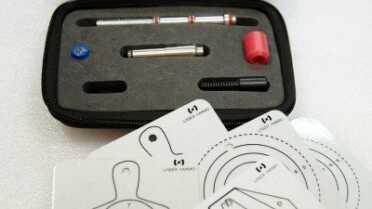
The basic 9mm SureStrike kit comes with everything you need to get started, including some cool reflective targets.
The SureStrike system is designed to fire a momentary beam of laser light through your handgun and provide feedback at the impact point. The kit includes several small targets of various styles that can be used, or you can simply pick a spot on the wall. If you want to take it to the next level, you add the Laser Ammo P.E.T. (Personal Electronic Target).
I spend as much time as I can using dry fire to keep my muscle memory tuned and to try to increase my performance. The biggest challenge in this type of training is being honest with yourself. Practice doesn’t make perfect—practice makes permanent. If you are not brutally honest when training and you allow yourself to accept “that was probably close enough”, then don’t expect your live fire skills to improve much. The SureStrike, combined with the P.E.T., gives you that important feedback. You either hit the target or you didn’t—period.
The SureStrike kit is available in several configurations. As tested, it came with the laser cartridge, an extension pipe, a safety extension and safety nut. Batteries are included. The basic kit is sufficient to fit barrel lengths from 2.9” to 4”. I was able to use the tool in a Glock 34 with its 5 ¼” barrel, but it was a “barely fits” scenario and required me to divert from the published instructions a bit. So, most of my time was spent using a Glock 17. You’ll note that both of these are 9mm pistols, which is the caliber that the cartridge is designed to fit. For larger calibers, you can obtain adapter rings that will easily convert the cartridge to fit the larger bores such as .40 S&W and .45 ACP. And there is also a length extension pipe that will make it properly fit that 5+” barrel on your match gun.
Another important consideration with dry fire practice is ensuring that it is done safely. Developing habits such as keeping any live ammunition out of the room used for dry fire; using aiming points that could handle the impact of an accidental discharge without a catastrophe, etc. Laser Ammo helps to even further ensure that you are training safely, because the laser cartridge is inserted into the breech – not the muzzle end, of the barrel. This physically prevents the firearm from becoming “loaded”, even if live ammo was accidentally introduced. The red safety nut is exposed at the muzzle end, providing the visible confirmation that “this gun is in training mode”.
The laser cartridge of the SureStrike is operated by impact from the firing pin. I like this design because it ensures that it fires every time, and you don’t have extra shots due to vibrations (like racking the slide or holstering, etc.). The P.E.T. is a small electronic target that is about the size of one and a half decks of cards in length, and about the same thickness as that same deck. There is a target area that covers the upper 2/3 of the unit – specially made to react to the laser strike. In the lower third are the controls – three buttons that allow you to turn the unit on and off, select from among the three target modes, and resetting the current mode. The three modes are: 1) Hit counter—keeps counting the number of hits until reset; 2) Shot timer / fast draw—provides a start signal and tracks the time until a successful hit; 3) Speed Shooting—this mode will time the shooter as if he were changing a magazine and subsequently
count how many times the shooter can hit the target within five seconds. My favorite by far is #2, the shot timer.
My typical time to draw from the holster and make a shot on target is in the 1.3- to 1.5-second neighborhood. This mode allows me to perform as many repetitions as I want, drawing the gun from the holster and breaking the first shot—which only counts if it’s a good hit—and tracking my progress. I can’t lie to myself about whether that shot was a good hit, and the P.E.T. won’t cut me any slack. If you miss, the timer just keeps running.
The P.E.T. comes with lots of cool accessories, too. For starters, the unit has a built-in tripod socket (1/4” x 20) on the bottom, and it comes with its own small tripod. You can just about set this thing anywhere and start training. You can also use the socket to attach it to a full-sized tripod or similar stand and take away the need for a level surface like a shelf. It also comes with several target inserts that reduce the size and shape of the strike zone. There are several round targets ranging in size from about 1 ½” down to a skill challenging ½” and a silhouette target. When placed just a few feet away with one of these inserts, the strike zone is equivalent to a life-sized target at 10-15 yards or more. I put a lot of reps on this electronic target and it never once had a hiccup.
The third product in this trifecta stands a bit apart. It is called the “Glock TJ Sight”, and it is a replacement for the rear sight on your Glock pistol. Just the rear sight—you leave the stock front sight on. This is a bit counter-intuitive—at least for me. I’ve never heard any instructor holler, “Rear sight! Rear sight!” to a student at the firing line. And more and more competitors are re-learning the benefit of blacked-out rear sights (often combined with a bright fiber optic front sight). So why does the Glock TJ Sight replace only the rear sight on your Glock and leave the front alone? Good question. As I was installing it, I was very curious how it was going to work for me. Laser Ammo recommends that you place the front sight over the rear sight (both are dots) and hold a six o’clock aim on your target. I found that pretty much works.
The TJ sight is very good quality (looks like aluminum construction) with a very long fiber-optic filament—about 1 ¼”. This gathers a ton of ambient light, especially sunlight, and glows brightly, so much so that I found it drew my eye directly to it. I haven’t decided yet if that is a good or bad thing. I’ve already stated that it is counter-intuitive, but my target acquisition did not seem to suffer much after just a few repetitions and getting the hang of it. You spot that orange dot, get your white dot on top of it, and press the trigger.
The TJ sight also comes equipped with a Tritium dot, which allows it to be easily seen in very low light or even complete darkness. Here is where I scratch my head a little more. If it is so dark that I need Tritium to see my rear sight… I’m betting that I won’t see my front sight at all. That rules this sight out immediately for any self-defense gun. And for any other use of it, you will need to spend some time re-training. I still don’t dislike the Glock TJ Sight—It performed so well for me that it won me over—but I still advise a lot of caution when considering it.
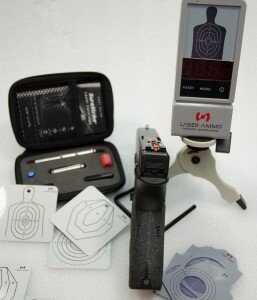
For less than the cost of a case of ammo, you can get a full training setup that you can use anywhere.
All in all, the folks at Laser Ammo offer some serious training products. These laser training tools are fun as heck to use, but they are by no means toys. Nor are they terribly cheap. Here’s a rundown of the list prices for the products tested:
– SureStrike 9mm kit $149.95
– LaserPET Electronic target $119.95
– Glock TJ Sight (Tritium) $110.00
To have a full training system for next-level dry-fire practice, you’re looking at roughly $270 for the SureStrike and the LaserPET—add a few bucks more if you need an extension pipe for a longer barrel. Sounds like a lot—but then consider how much live ammo you can buy for that same price, and how long it would last you doing drills at the range. Suddenly, it seems pretty reasonable doesn’t it? My experience with the Laser Ammo products tells me that these people are serious about making useful training tools, and they’re getting it right. Whether it is used to help teach a new shooter the fundamentals or to help a seasoned competitor shave tenths of a second from her time, the Laser Ammo products are serious training tools that work.
[/full_width]
[one_half]
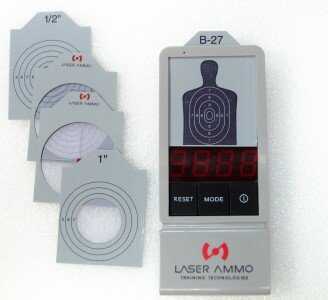
The LaserPET is a well-made training tool and comes with several challenging target shapes and sizes.
[/one_half]
[one_half_last]

The SureStrike laser cartridge installs in the breech of the barrel, not the front. This prevents any possibility for live ammo to be loaded into the gun.
[/one_half_last]

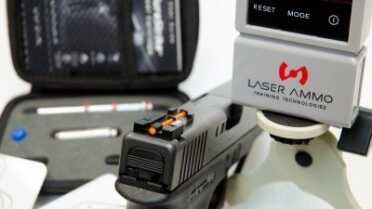

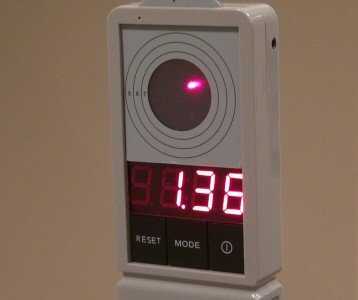
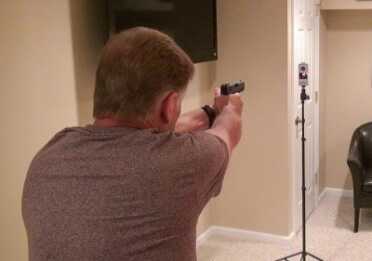
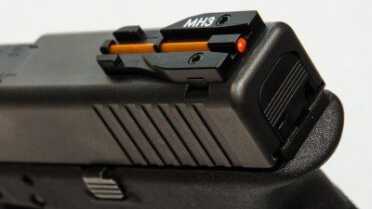
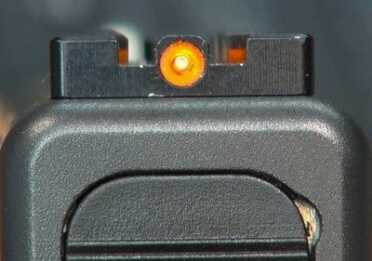

I’ve been looking into some laser training tools and have seen a few youtube videos on this and mantis products, do you know how they compare or know other good systems out there?
For what it is, all laser systems are seriously over priced…that is an obvious fact of life.
We need somebody to enter the game who charges an honest price for such items, and until they do so, I am not remotely interested in buying one of the outlandishly expensive systems out there right now…no way. I suspect that my view of things is also the viewpoint of most of the people out there.
The statement that it is cheaper than a trip to the range is a red herring…you still require live ammo shooting to retain proficiency…and these systems are very definitely badly over priced for what they offer.